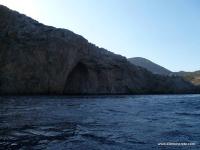 Monte Vardia: Introduction
Monte Vardia: Introduction
This is a really interesting spot! I've been for the first time just a few months ago and been really impressed. It's just a breath from the city centre with superb view to the city of Chania and the harbour. The climbing area consists of a face around 100 meters wide and up to 12 high. It's well bolted and you wont face any run out here. You can climb all year long in Monte Vardia except the very hot summer days and between 13:00 to 17:00 o'clock. Having said that, if you are from northern Europe and you really like sun you can give a try ![]() .
.
 Agiofarago: Introduction
Agiofarago: Introduction

The southernmost climbing area in Crete is Agiofarago. The area's characteristic is the rock, which is very sharp, along with the combination of climbing, swimming and walking. Most of the routes are inside the gorge with the oldest ones situated on the beach or near the beach. Here you will find some of the most difficult routes in Crete, up to 8b+, from single to multiple pitches. There are just a few lower than 5c where most of them are around 6c/7a. Almost 90% of the climbing routes are equipped and you will only need quickdraws and 60-70 meters of single rope to repeat them. Having said that, there are also many where natural anchors must be used. Those are usually the first routes in the area opened in late 80s. The place is marvellous and you will enjoy climbing and swimming in one of the most beautiful places not only in Crete but also in Greece!
 Introduction
IntroductionMalia is surrounded by olive groves and the slopes of mount Selena. Malia is best known for its lively atmosphere; however Malia is not only for young people, it has a lot to offer everyone (almost) especially if you visit the old city and a few km before the traditional village of Koutouloufari, you wont regret it. The beach is the one of the best in Crete, three miles of fine, golden sand, which gradually slopes into the warm, clear blue sea. Just a few km away there is a climbing spot too :)
 An overview of climbing in Dikti
An overview of climbing in Dikti
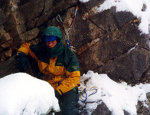 In Dikti you will find the best climbing spot for climbers who are looking for to try traditional climbing routes without dealing with high grades of difficulty. The most difficult rock climbing route is around 6a+ and there are plenty near to 5a/5b+. Having said that, the long routes, the loose rock in places and the long (in some routes) access, contributes to an absolute adventure.
In Dikti you will find the best climbing spot for climbers who are looking for to try traditional climbing routes without dealing with high grades of difficulty. The most difficult rock climbing route is around 6a+ and there are plenty near to 5a/5b+. Having said that, the long routes, the loose rock in places and the long (in some routes) access, contributes to an absolute adventure.
During winter, things are more complicated. Rock, frozen snow and rarely ice, lead to the ultimate escape from the daily routin. Be aware that winter climbing in Dikti's gullies are quiet difficult and is not recommended for newbies.
 Plakias: Introduction
Plakias: IntroductionThis is a huge slab! Some really hard routes are here. The main cliff of Plakias is just a few meters away from the beach (superb for swimming) with excellent quality of rock and up to 80 meters high. Some bolts need to be replaced but most of them are ok to climb. It faces north west and is possible to climb almost all day even during the summer. There is a camping to stay and plenty of hotels in the area. to reach the clmbing routes all you need is a 2 minutes walk. There are some fantastic routes in this area.
 Agia Paraskeui Cave: Introduction
Agia Paraskeui Cave: IntroductionThis is one of the three largest caves in the prefecture of Heraklion.It's just a few minutes driving from the village of Skotino and is at a height of 225 meters above sea-level. Many dyno's here! There is one route at 5b, one at 5c and 3 between 6a+ and 6c. Rest are really hard, up to 8b+, maybe more. It's a lovely place to climb during the summer as it's always in the shadow.
 Kleissoura gorge: Introduction
Kleissoura gorge: IntroductionIn this area newbies can't do a lot unless you can climb easily 6c. There are 5 routes under 6a and around 20 between 6b to 7b+. The place is too warm to climb during the summer but ideal during the winter. The area is located before reaching the village of Tries Ekklisies and you'll see it on the left as you going down. All you need is 2-3 minutes walking to get to the starting point.
 Therissos Introduction
Therissos Introduction
The 14 km drive up the gorge is considered spectacular and is popular with Chania residents for the cooler temperatures and grill restaurants of the village. Apart from this there is also interesting for rock climbing ![]() . Here there are many routes for all tastes. Along the road to the village of Therissos you will see all the routes that vary from V up to X- (UIAA) and almost all of them are protected with bolts. In some of them you may need nuts, friends and some slings. You will certainly enjoy your climbing here as long as you climb easily 6a/6b as most of the routes are close to that level. The easiest climbing area is the one with graffiti ''ΛΟΚ'', the initials of the Greek Special forces who use this area for rock climbing training. You will get a detailed view of the climbing sectors by choosing any of them from the top menu. In the mean while let's get you informed about some other important aspects of the area! This climbing area is the most important for local climbers as in just a few minutes from Chania you can get there and start climbing a large number of routes.
. Here there are many routes for all tastes. Along the road to the village of Therissos you will see all the routes that vary from V up to X- (UIAA) and almost all of them are protected with bolts. In some of them you may need nuts, friends and some slings. You will certainly enjoy your climbing here as long as you climb easily 6a/6b as most of the routes are close to that level. The easiest climbing area is the one with graffiti ''ΛΟΚ'', the initials of the Greek Special forces who use this area for rock climbing training. You will get a detailed view of the climbing sectors by choosing any of them from the top menu. In the mean while let's get you informed about some other important aspects of the area! This climbing area is the most important for local climbers as in just a few minutes from Chania you can get there and start climbing a large number of routes.
Area Info
Great routes around 6a-6c in this sector just a breath near sector 15 with the easies routes in the area.
Area Info
This sector is just after Agios Antonios church on the left as you are walking to the beach. Great routes here too. All routes in this sector opened from Philippe Bugada and Vaggelis Floros in 2007.
Area Info
This sector is located just a few meters before the beach on the left as you are gazing the excellent beach. Many beautiful routes in this sector. One of those (the 1st) is traditional and quite hard (6b, harder than it looks) and it takes a lot of gear, especially middle size friends. A must-climb route.
Area Info
Three minutes away from sector 2 this one holds 4 routes, up to 7a and not higher than 22 meters. All routes opened from Manolis Kampourakis and Aris Mavromatis. A topo of the sector will be added soon.
Area Info
This sector is the characteristic big cave on the left of the gorge before the church of Agios Antonios. Only hard routes here, up to 8c (maybe more).
Area Info
Plenty of routes here if you climb above 7b. This sector is on the right side of the cave.
Area Info
This sector is located just on the right of the big cave before the church of Agios Antonios. One of the greatest routes in the area exist here, that is "Cathedral Wall", a superb two pitches route opened from Zbynek Cepela. The first pitch of that route was initially 5c+ but after a while a broken hold lead the route up to 6b!
Area Info
One small (30 meters) and two multi pitches routes exist in this sector/area just above the sea. All routes have no bolts at all so full climbing equipment needed.
Area Info
This sector has just two routes and the biggest one in the whole gorge with 235 meters (7 pitches) in total length, fully bolted! Helmet, water and a lightweight shoe is necessary to complete the route along with 2x50 meter ropes.
Both routes opened by Philippe Bugada in 2007.
Area Info
This sector is located on the right side of the gorge as you're walking through the gorge with direction to the beach from the main path starting from the monastery of Odigitrias and not the one from Kaloi Limenes. It is the characteristic huge cave. Before the cave there is one more trad route under construction (around 5b+). Hopefully we will go back and finish the route sometime during the upcoming months. At the moment just the first pitch has been climbed (40 meters) and left a sling for belay. You can see a topo of the route on the next page of this article (page 2 link on the bottom of the page).
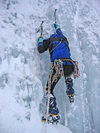

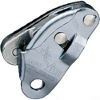
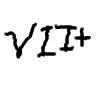
Latest forum topics
(Posted on: 11/02/2017 by Vincent)
(Posted on: 29/01/2017 by John87)
(Posted on: 29/01/2017 by Guest)
(Posted on: 29/01/2017 by John87)
(Posted on: 20/09/2016 by sardiman)

